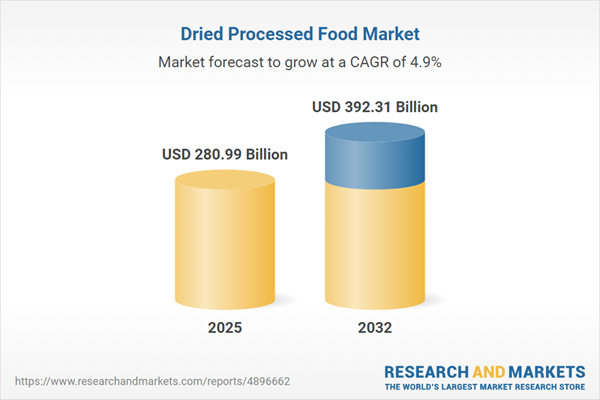Speak directly to the analyst to clarify any post sales queries you may have.
The dried processed food market is evolving rapidly as digital innovation, regulatory change, and shifting consumer preferences reshape competitive strategies and industry models. Senior executives require targeted insight to anticipate shifts and drive sustainable growth in this complex market landscape.
Market Snapshot: Growth Trajectory in the Dried Processed Food Market
The dried processed food market is charting robust growth, with a current valuation of USD 267.60 billion in 2024. Market value is projected to reach USD 280.99 billion in 2025, and forecasts indicate expansion to USD 392.31 billion by 2032, supported by a compound annual growth rate (CAGR) of 4.89%. This upward trajectory reflects broad-based momentum, driven by rising health awareness, consistent product innovation, and agile business operations. Both mature and emerging markets contribute to sector expansion as consumer habits shift and procurement methods evolve. The emphasis on agility and resilience in strategic planning is sharpening, as industry leaders focus on seizing opportunities across short- and long-term horizons.
Scope & Segmentation of the Dried Processed Food Industry
This report thoroughly examines essential market drivers, segments, and actionable trends to empower informed decisions and define future-oriented strategies. The segmentation structure enables the identification of opportunity areas and supports the development of tailored growth approaches.
- Product Types: Dried fruits and vegetables offer strong nutritional value and flexible application across consumer and industrial needs. Their popularity sustains steady demand in diverse product ranges.
- Distribution Channels: Convenience stores, supermarkets, hypermarkets, specialist retailers, proprietary e-commerce sites, and third-party digital platforms influence consumer access and reinforce brand positioning.
- End Users: The sector supplies households searching for convenience, foodservice providers aiming to diversify menus, and industrial players incorporating dried ingredients into bakery, snack, and beverage lines.
- Packaging Types: Choices such as plastic or kraft bags, jars, cartons, shipping containers, gift-friendly wraps, and stand-up pouches serve critical roles for branding, product safety, and supply chain efficiencies.
- Regions: The Americas, Europe, Asia-Pacific, and Middle East & Africa provide scope for in-depth analysis of purchasing trends, regulations, and competitive environments at both regional and country level.
- Technologies: Dehydration advancements, sensor-based monitoring, and analytics technologies enable sustained shelf life, traceability, and process improvement within manufacturing and quality management.
- Key Companies: Influential firms including Cargill, Archer-Daniels-Midland Company, Olam International, General Mills, Conagra Brands, Kerry Group, Ingredion, McCormick & Company, Tate & Lyle, and SunOpta shape industry direction with ongoing innovation and global investments.
Key Takeaways for Senior Decision-Makers
- Transparency in ingredient sourcing, demand for clean-label products, and diverse flavor development are motivating accelerated product innovation adaptable to changing market preferences.
- Packaging advancements, including resealable and eco-friendly solutions, create brand distinction and meet evolving buyer expectations for functionality and sustainability.
- Technological improvements in dehydration and digital monitoring optimize production, enable cost control, and facilitate rapid response to health-driven trends.
- The competitive landscape integrates established global entities alongside nimble local suppliers and new entrants, resulting in a dynamic mix that increases market responsiveness.
- Procurement strategies now prioritize robust supplier relationships and diversified sourcing models to mitigate risk and address persistent market disruptions.
- Collaboration with foodservice and industrial end users is growing, promoting co-development of products and unlocking new opportunities in untapped categories.
Tariff Impact and Market Accessibility
Recent tariff adjustments in the United States are driving major reassessments of procurement and sourcing strategies across the dried processed food market. Companies are expanding into regions with more favorable tariff conditions and increasing nearshoring to address cost pressures and reduce supply chain exposure. These changes are strengthening supply chain resilience while evolving access to key markets.
Methodology & Data Sources
The findings in this report are based on comprehensive desk research, regulatory review, and direct interviews with senior executives. Quantitative forecasts utilize robust economic and trade indicators, while expert scenario mapping and validation ensure practical and reliable guidance for strategic initiatives.
Why This Report Matters for Industry Leaders
- Identifies the most attractive market segments, supporting fact-based decisions for profit growth and resource allocation across channels, products, and geographies.
- Offers a unified analysis covering technology, operations, and the regulatory framework essential for market positioning and compliance in the dried processed food sector.
- Supports the development of adaptable strategies capable of balancing market risk with the agility required to navigate an evolving landscape.
Conclusion
Continual innovation and alignment with emerging trends remain crucial for sustainable growth in the dried processed food market. Equipped with detailed insights, industry leaders can strengthen their competitive positioning and drive value creation for the future.
Additional Product Information:
- Purchase of this report includes 1 year online access with quarterly updates.
- This report can be updated on request. Please contact our Customer Experience team using the Ask a Question widget on our website.
Table of Contents
3. Executive Summary
4. Market Overview
7. Cumulative Impact of Artificial Intelligence 2025
Companies Mentioned
The companies profiled in this Dried Processed Food market report include:- Cargill, Incorporated
- Archer-Daniels-Midland Company
- Olam International Limited
- General Mills, Inc.
- Conagra Brands, Inc.
- Kerry Group PLC
- Ingredion Incorporated
- McCormick & Company, Incorporated
- Tate & Lyle PLC
- SunOpta Inc.
Table Information
| Report Attribute | Details |
|---|---|
| No. of Pages | 180 |
| Published | November 2025 |
| Forecast Period | 2025 - 2032 |
| Estimated Market Value ( USD | $ 280.99 Billion |
| Forecasted Market Value ( USD | $ 392.31 Billion |
| Compound Annual Growth Rate | 4.8% |
| Regions Covered | Global |
| No. of Companies Mentioned | 11 |









